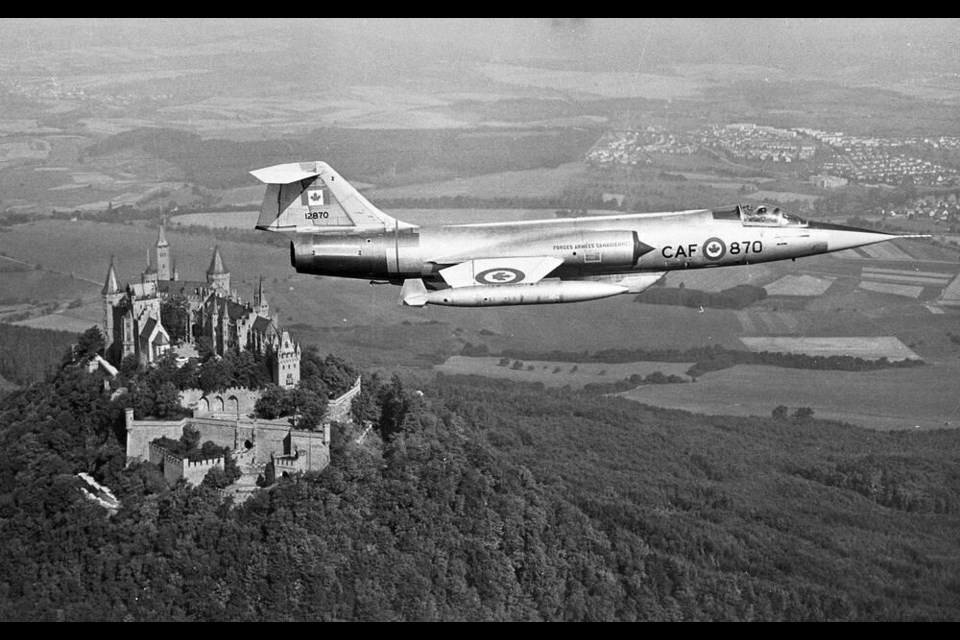How do you move a vintage supersonic jet with no engine from CFB Comox to Victoria International Airport?
At night.
And with a very skilled crew using a large flatbed truck and trailer.
If you happen upon a light-flashing convoy carrying a CF-104 Starfighter in the early morning hours of Thursday or Friday, it’s headed to the B.C. Aviation Museum at the airport as its newest display.
The Canadair Starfighter — which is 54 feet long with a 22-foot wing span and weighing 10,000 pounds — was Canada’s Cold War supersonic, nuclear-capable jet, used mostly in Europe from 1962 until it was replaced by the CF-18 Hornets in 1987.
The jet is a gift to the aviation museum from CFB Comox. Nickel Brothers, the company that moves houses and anything huge and unwieldy, is doing the move.
“It’s a technical and operational feat and a two-year process just to get it here,” said Steve Nichol, president of the B.C. Aviation Museum. “But you know if anyone can do it, it’s Nickel Brothers. They move anything and they do it very well.”
The museum is paying Nickel Brothers $21,000 to move the jet. The plan is to restore the Starfighter to its original colours and decals, remove the wings to address corrosion issues and eventually display it at the museum.
The jet is expected to arrive either today or Friday morning, depending on how the travel unfolds, said Nichol. It may stop overnight at the Nickel Brothers’ Nanaimo yard today, and resume the trip the following day.
Several pilots who flew the Starfighter and retired in Victoria will be on hand to see the jet’s arrival, including Ken Lett, one of the original pilots and the first squadron leader for the Starfighter in Cold Lake, Alta.
A member of the Canadian Aviation Hall of Fame, Lett turns 100 on July 13 and led a storied career, including flying a Spitfire during the Normandy landings on D-Day.
Retiring as a major-general, Lett flew Vampires, F-86 Sabres, CF-104 Starfighters and the CF-101, among other aircraft, over the course of his career.
Nichol said the Starfighter, although primarily used by the Canadian Air Force in Europe and for training at Cold Lake, Alta., is an important piece of aviation history that should be restored.
“It was an absolute hot rod,” said Nichol. “In terms of speed, very few could catch a Starfighter. I’ve never met a pilot who didn’t love it.”
Nichol’s own father flew a Starfighter when he was stationed in France.
The Starfighter has very thin and stubby wings, a distinctive T tail and a powerful engine.
While the small wing area resulted in poor turning capability and high landing speeds, it had excellent acceleration and became the first production aircraft to achieve Mach 2 (twice the speed of sound), and to reach an altitude of 100,000 feet following a takeoff under its own power.
Entering service with the United States Air Force in 1958, designer Kelly Johnson’s Starfighter was the first aircraft to simultaneously hold world records for speed, altitude and time-to-climb.
The Starfighter was widely touted as “a missile with a man in it,” said Nichol.
The Starfighter had a relatively short front-line career with the United States Air Force, but saw long service in 15 countries, with 2,578 jets produced.
Despite its design as a high-altitude interceptor, Canadair Ltd. of Montreal produced 200 single-seat Starfighters optimized for a low-level, nuclear strike role.
Designated the CF-104, the Canadian variant featured a strengthened fuselage and wings, robust landing gear and a special hardpoint for either a nuclear weapon or a reconnaissance camera pod, according to the aviation museum.
Eight RCAF squadrons in Europe were equipped with the CF-104 as a major NATO commitment. At the end of 1971, Canada switched from a nuclear to a conventional attack role that saw the Starfighter re-equipped with conventional bombs, rockets and the M-61 Vulcan Gatling gun.
The CF-104 is the fastest aircraft Canada ever deployed and the only one that had a nuclear-strike role, said Nichol.
It also holds the Canadian altitude record of 100,110 feet set in 1967 by Robert “Bud” White, a Vancouver resident.
The Starfighter will complement the museum’s other jet aircraft from the Cold War era — a Lockheed CT-133 Silver Star trainer.
The museum’s Starfighter was produced in 1962 and based at RCAF Station Cold Lake until April 1991, when it was transferred to the Comox Military Museum.
>>> To comment on this article, write a letter to the editor: [email protected]



